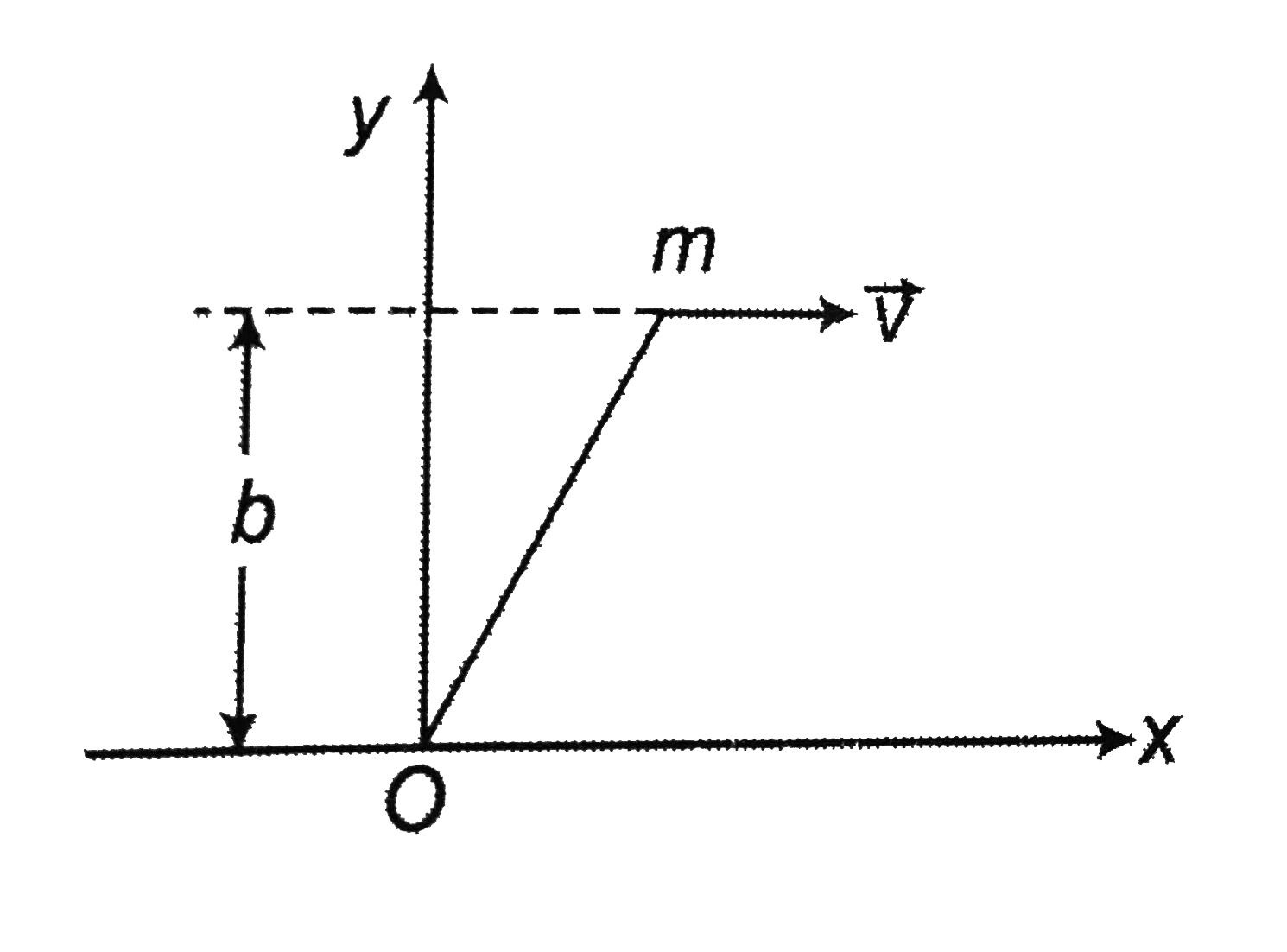A particle of mass m is moving with constant speed v on the line y=b in positive x-direction. Find its angular momentum about origin, when position coordinates of the particle are (a, b).
mvb
mvb/2
mvb/4
none
The correct Answer is:A
To find the angular momentum of a particle of mass m moving with constant speed v along the line y=b at the position coordinates (a,b), we can follow these steps:
Step 1: Understand the Concept of Angular Momentum
Angular momentum L about a point (in this case, the origin) is given by the formula:
L=m⋅v⋅r
where:
- m is the mass of the particle,
- v is the velocity of the particle,
- r is the distance from the point about which we are calculating the angular momentum to the line of action of the velocity.
Step 2: Identify the Position and Velocity
The particle is at position (a,b) and is moving in the positive x-direction with a constant speed v.
Step 3: Calculate the Distance r
The distance r from the origin to the particle can be calculated using the Pythagorean theorem:
r=√a2+b2
Step 4: Determine the Perpendicular Component of Velocity
Since the velocity is in the x-direction, we need to find the component of this velocity that is perpendicular to the radius vector r. The angle θ between the radius vector and the x-axis can be found using:
sinθ=b√a2+b2
Thus, the perpendicular component of the velocity is:
v_{\perpendicular} = v \cdot \sin \theta = v \cdot \frac{b}{\sqrt{a^2 + b^2}}
Step 5: Substitute into the Angular Momentum Formula
Now we can substitute v_{\perpendicular} into the angular momentum formula:
L = m \cdot v_{\perpendicular} \cdot r = m \cdot \left(v \cdot \frac{b}{\sqrt{a^2 + b^2}}\right) \cdot \sqrt{a^2 + b^2}
Step 6: Simplify the Expression
The √a2+b2 terms cancel out:
L=m⋅v⋅b
Final Answer
Thus, the angular momentum L of the particle about the origin is:
L=m⋅v⋅b
Angular momentum L about a point (in this case, the origin) is given by the formula:
L=m⋅v⋅r
where:
- m is the mass of the particle,
- v is the velocity of the particle,
- r is the distance from the point about which we are calculating the angular momentum to the line of action of the velocity.
The particle is at position (a,b) and is moving in the positive x-direction with a constant speed v.
The distance r from the origin to the particle can be calculated using the Pythagorean theorem:
r=√a2+b2
Since the velocity is in the x-direction, we need to find the component of this velocity that is perpendicular to the radius vector r. The angle θ between the radius vector and the x-axis can be found using:
sinθ=b√a2+b2
Thus, the perpendicular component of the velocity is:
v_{\perpendicular} = v \cdot \sin \theta = v \cdot \frac{b}{\sqrt{a^2 + b^2}}
Now we can substitute v_{\perpendicular} into the angular momentum formula:
L = m \cdot v_{\perpendicular} \cdot r = m \cdot \left(v \cdot \frac{b}{\sqrt{a^2 + b^2}}\right) \cdot \sqrt{a^2 + b^2}
The √a2+b2 terms cancel out:
L=m⋅v⋅b
Thus, the angular momentum L of the particle about the origin is:
L=m⋅v⋅b
Topper's Solved these Questions
- RACEBOOK - ALLENCHAPTER - RACEEXERCISE - Basic Maths (GRAVITATION)
25 Videos
- RACEBOOK - ALLENCHAPTER - RACEEXERCISE - Basic Maths (Properties of Matter & Fluid Mechanics)(Elasticity)
20 Videos
- RACEBOOK - ALLENCHAPTER - RACEEXERCISE - Basic Maths (COLLISION AND CENTRE OF MASS )
12 Videos
- NEWTONS LAWS OF MOTIONBOOK - ALLENCHAPTER - NEWTONS LAWS OF MOTIONEXERCISE - EXERCISE-III
28 Videos
- SIMPLE HARMONIC MOTIONBOOK - ALLENCHAPTER - SIMPLE HARMONIC MOTIONEXERCISE - Example
1 Videos
Similar Questions
A particle is moving with constant speed v along the line y = a in positive x -direction. Find magnitude of its angular velocity about orgine when its position makes an angle θ with x-axis.
View SolutionA particle is moving with constant speed v along the line y = a in positive x -direction. Find magnitude of its angular velocity about orgine when its position makes an angle θ with x-axis.
View SolutionA particle is moving with constant speed v along x - axis in positive direction. Find the angular velocity of the particle about the point (0, b), when position of the particle is (a, 0).
View SolutionA particle of mass m is moving with constant velocity v parallel to the x-axis as shown in the figure. Its angular momentum about origin O is

View SolutionA particle is moving with constant speed v in xy plane as shown in figure. The magnitude of its angular velocity about point O is

View SolutionA particle of mass m is travelling with a constant velocity v=v0ˆi along the line y=b,z=0. Let dA be the area swept out by the position vector from origin to the particle in time dt and L the magnitude of angular momentum of particle about origin at any time t. Then
View SolutionIf the particle of mass m is moving with constant velocity v parallel to x-axis in x-y plane as shown in (figure), Find its angular momentum with respect of origin at any time t.

View SolutionA particle of mass m is moving along the line y=b,z=0 with constant speed v. State whether the angular momentum of particle about origin is increasing, decreasing or constant.
View SolutionA particle of mass m is moving along the line y=b,z=0 with constant speed v. State whether the angular momentum of particle about origin is increasing. Decreasing or constant.
View SolutionA particle of mass m=5 units is moving with a uniform speed v=3√2 units in the XY-plane along the y=x+4. The magnitude of the angular momentum about origin is
View Solution
